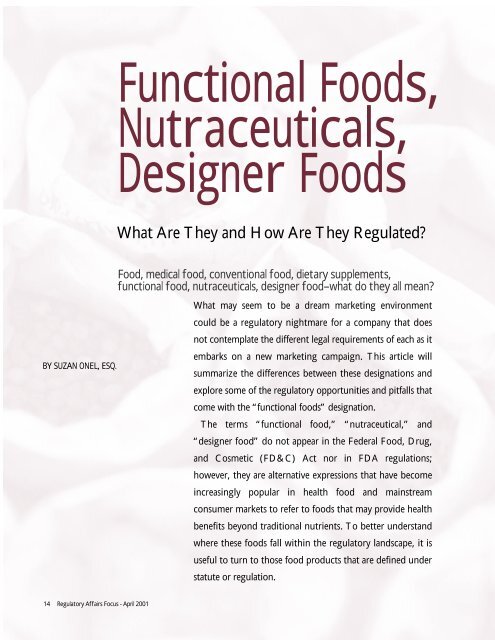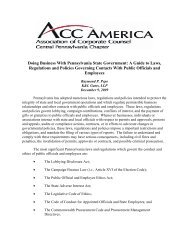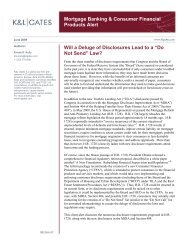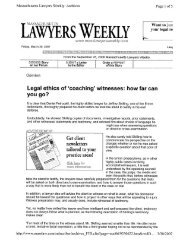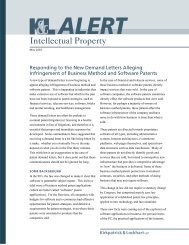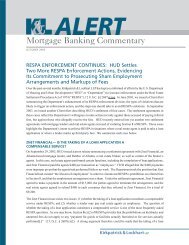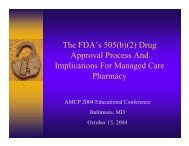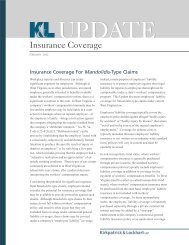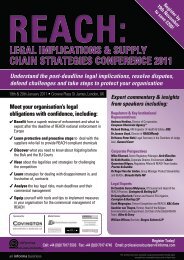Functional Foods, Nutraceuticals, Designer Foods
Functional Foods, Nutraceuticals, Designer Foods
Functional Foods, Nutraceuticals, Designer Foods
You also want an ePaper? Increase the reach of your titles
YUMPU automatically turns print PDFs into web optimized ePapers that Google loves.
<strong>Functional</strong> <strong>Foods</strong>,<br />
<strong>Nutraceuticals</strong>,<br />
<strong>Designer</strong> <strong>Foods</strong><br />
What Are They and How Are They Regulated?<br />
BY SUZAN ONEL, ESQ.<br />
Food, medical food, conventional food, dietary supplements,<br />
functional food, nutraceuticals, designer food–what do they all mean?<br />
What may seem to be a dream marketing environment<br />
could be a regulatory nightmare for a company that does<br />
not contemplate the different legal requirements of each as it<br />
embarks on a new marketing campaign. This article will<br />
summarize the differences between these designations and<br />
explore some of the regulatory opportunities and pitfalls that<br />
come with the “functional foods” designation.<br />
The terms “functional food,” “nutraceutical,” and<br />
“designer food” do not appear in the Federal Food, Drug,<br />
and Cosmetic (FD&C) Act nor in FDA regulations;<br />
however, they are alternative expressions that have become<br />
increasingly popular in health food and mainstream<br />
consumer markets to refer to foods that may provide health<br />
benefits beyond traditional nutrients. To better understand<br />
where these foods fall within the regulatory landscape, it is<br />
useful to turn to those food products that are defined under<br />
statute or regulation.<br />
14 Regulatory Affairs Focus - April 2001
Food<br />
“Food” is defined in the FD&C Act<br />
as “(1) articles used for food or drink<br />
for man or other animals, (2) chewing<br />
gum, and (3) articles used for components<br />
of any such article” (FD&C Act<br />
§ 201(f)). In reviewing this definition,<br />
the US Court of Appeals for the<br />
Seventh Circuit stated that “the<br />
statutory definition of ‘food’ includes<br />
articles used by people in the ordinary<br />
way most people use food – primarily<br />
for taste, aroma, or nutritive value”<br />
(Nutrilab Inc. v. Schweiker, 713 F.2d<br />
335, 338 [7 th Cir. 1983]). This interpretation<br />
has been accepted by FDA<br />
and other federal courts.<br />
Medical Food<br />
“Medical food” is a distinct category<br />
of food that is specially formulated to<br />
be consumed or administered enterally<br />
(i.e., by mouth or through a tube or<br />
catheter), normally under the supervision<br />
of a physician, and which is<br />
intended for the specific dietary<br />
management of a disease or condition<br />
for which distinctive nutritional<br />
requirements are established by<br />
medical evaluation (21 CFR §<br />
101.9(j)(8) 1 ). A medical food is<br />
permitted to make claims that address<br />
a patient’s special dietary needs that<br />
exist because of a disease; but it is not<br />
authorized to bear claims to cure,<br />
mitigate, treat or prevent a disease,<br />
which are drug claims under the<br />
FD&C Act.<br />
Conventional Food<br />
The concept of “conventional food”<br />
is––to a large extent––an outgrowth of<br />
the Nutrilab case and, ultimately, the<br />
Dietary Supplement Health and<br />
Education Act of 1994 (DSHEA).<br />
The Nutrilab definition of food<br />
focused on its primary characteristics:<br />
taste, aroma, and nutritive value. With<br />
DSHEA, the concept of food was<br />
expanded to include dietary supplements.<br />
With this statutory change,<br />
tablets, capsules, powders, softgels,<br />
gelcaps, and liquids intended for<br />
ingestion could be considered food<br />
products. To distinguish these food<br />
products from those ingested primarily<br />
for their taste, aroma, and nutritive<br />
value, it has become useful to refer to<br />
the latter as “conventional food.”<br />
Interestingly, under DSHEA, dietary<br />
supplements in the form of tablets,<br />
capsules, etc., would not be considered<br />
conventional food; however, conventional<br />
food products such as cereals,<br />
food bars, and sports drinks could be<br />
described as dietary supplements if<br />
they are represented as something<br />
other than conventional food and<br />
meet the other DSHEA requirements<br />
(see further discussion below).<br />
Dietary Supplement<br />
A “dietary supplement” is defined<br />
under DSHEA as a product “intended<br />
to supplement the diet” that contains<br />
one or more of the following dietary<br />
ingredients: vitamin; mineral; herb or<br />
other botanical; amino acid; dietary<br />
substance for use by man to<br />
supplement the diet by increasing the<br />
total dietary intake; or concentrate,<br />
metabolite, constituent, extract, or<br />
combination of any ingredient<br />
described above (FD&C Act §<br />
201(ff)(1)). As noted above, a dietary<br />
supplement also can be marketed in<br />
other forms, but, by statute, it must be<br />
“labeled as a dietary supplement” and<br />
cannot be “represented for use as a<br />
conventional food or as a sole item of a<br />
Regulatory Affairs Focus - April 2001 15
FUNCTIONAL FOODS, NUTRACEUTICALS, DESIGNER FOODS<br />
meal or the diet” (FD&C Act §<br />
201(ff)(2)(B)-(C)).<br />
Under DSHEA, a dietary supplement<br />
manufacturer is not required to<br />
obtain premarketing clearance from<br />
FDA if the ingredients have been<br />
marketed in the US before October<br />
15, 1994. Additionally, dietary<br />
supplement dietary ingredients are<br />
specifically excluded from the<br />
definition of a “food additive” (FD&C<br />
Act § 201(s)(6)). Thus, a product<br />
containing echinacea, kava kava,<br />
and/or St. John’s wort, for example,<br />
could be marketed in the US as a<br />
dietary supplement without FDA<br />
review or preclearance of the product’s<br />
safety.<br />
<strong>Functional</strong> Food<br />
“<strong>Functional</strong> foods” have, to a large<br />
extent, grown out of industry’s desire<br />
to apply the claims and apparent<br />
regulatory flexibility available to<br />
dietary supplements to conventional<br />
food products. This term has been<br />
applied to a broad spectrum of<br />
products from herbal teas and soups to<br />
soft drinks and snack bars, but has no<br />
formal definition or clear regulatory<br />
framework. However, there is a<br />
general understanding that products<br />
described as “functional foods” tend to<br />
be conventional food products with<br />
health-promoting ingredients or<br />
components that go beyond their<br />
traditional nutritive value.<br />
Notwithstanding this general understanding,<br />
from a regulatory standpoint,<br />
functional food products fall<br />
into the legal category defined above<br />
as “food.” As such, unlike dietary<br />
supplements, functional food ingredients<br />
must be either approved food<br />
additives or ingredients that are<br />
“generally recognized as safe” (GRAS)<br />
by qualified experts under the conditions<br />
of the intended use. 2<br />
Additionally, their labeling claims must<br />
be consistent with the general food<br />
provisions of the FD&C Act and its<br />
implementing regulations. These<br />
distinctions are important to keep in<br />
mind since they mean that products<br />
that contain the same dietary ingredients<br />
but are labeled as either dietary<br />
supplements or functional foods will<br />
have different safety and labeling<br />
requirements.<br />
Safety<br />
As recently as January 30, 2001, in a<br />
letter to manufacturers, FDA expressed<br />
concern over the “significant<br />
growth in the marketplace of conventional<br />
food products that contain novel<br />
ingredients, such as added botanical<br />
ingredients or their extracts that have<br />
not previously been used as food<br />
ingredients.” 3 In this letter, FDA<br />
reiterated that “some of the herbal and<br />
other botanical ingredients that are<br />
being added to conventional foods<br />
may cause the food to be adulterated<br />
because these added ingredients are<br />
not being used in accordance with<br />
approved food additive regulations and<br />
may not be GRAS for their intended<br />
use.” 4<br />
FDA has issued numerous warning<br />
letters to companies incorporating<br />
dietary ingredients widely used in the<br />
dietary supplement market into<br />
conventional food products. For<br />
example, in a warning letter to a juice<br />
manufacturer, FDA identified ingredients<br />
such as echinacea, grape seed<br />
extract, and gingko biloba as inappropriate<br />
food ingredients. The letter<br />
stated: “FDA has not issued a food<br />
additive regulation authorizing the use<br />
of these ingredients in food.<br />
Additionally, we are not aware of a<br />
basis for concluding that these ingredients<br />
are GRAS for use in conventional<br />
food.” 5 In another warning<br />
letter, sent to a snack food company,<br />
FDA identified echinacea, gingko<br />
biloba, St. John’s wort, cat’s claw, kava<br />
kava and spirulina as inappropriate<br />
food ingredients in that they were not<br />
subject to an authorizing food additive<br />
regulation and the agency was<br />
unaware of a basis for concluding that<br />
they were GRAS. 6<br />
While FDA, at this time, has taken<br />
no further enforcement action against<br />
these companies, the Center for<br />
Science and the Public Interest (CSPI)<br />
has submitted 13 letters to FDA as of<br />
July 2000 urging further action<br />
against such products under the<br />
adulteration and misbranding provisions<br />
of the FD&C Act. The General<br />
Accounting Office (GAO) also investigated<br />
FDA’s regulation of functional<br />
foods and issued a report in July 2000<br />
entitled, “Improvements Needed in<br />
Overseeing the Safety of Dietary<br />
Supplements and ‘<strong>Functional</strong> <strong>Foods</strong>’”<br />
(GAO/RCED-00-156). In response,<br />
FDA indicated in its Center for Food<br />
Safety and Applied Nutrition<br />
(CFSAN) fiscal 2001 Program<br />
Priorities, that one of its “A” list goals<br />
is to “define boundaries among<br />
product categories,” in particular<br />
“ensuring that dietary supplement<br />
ingredients, when added to conventional<br />
food, are lawful.”<br />
Thus, manufacturers of functional<br />
food products need to be cognizant of<br />
the different safety rules that apply to<br />
functional food products as distinguished<br />
from dietary supplements––at<br />
least until the term “functional food”<br />
is further defined by statute or<br />
regulation.<br />
Labeling<br />
As discussed under the dietary<br />
supplement section, a functional food<br />
potentially could be regulated as a<br />
dietary supplement product if it meets<br />
the requirements of DSHEA––most<br />
importantly, if it is labeled as a dietary<br />
supplement and not represented for<br />
use as a conventional food. However, a<br />
common fallacy is that a functional<br />
food can be bootstrapped into the<br />
dietary supplement category by simply<br />
adding traditional herbal and/or<br />
botanical ingredients and labeling the<br />
16 Regulatory Affairs Focus - April 2001
product a dietary supplement. FDA<br />
has shown that it will look beyond the<br />
labeled representation to the intended<br />
use of the product.<br />
The most well known examples of<br />
FDA looking beyond a product’s<br />
labeled representations in the<br />
functional food context are Benecol ®<br />
and Take Control ® . Both products<br />
contained phytosterols and originally<br />
were characterized as dietary<br />
supplement “margarine substitutes.”<br />
However, based on this description as<br />
well as prototype labeling promoting<br />
the product’s flavor and texture<br />
presented to FDA during a premarketing<br />
meeting, FDA stated that<br />
Benecol ® , and similarly marketed<br />
products such as Take Control ® ,<br />
“while labeled as a dietary supplement,<br />
bears label representations that<br />
establish the intent of this product to<br />
do more than supplement the diet.” 7<br />
As such, FDA stated that the<br />
marketing of the product as a dietary<br />
supplement “would be illegal under<br />
the Federal Food, Drug, and<br />
Cosmetic Act.” 7 After subsequent<br />
meetings and discussions with the<br />
agency, including the submission of<br />
GRAS notification documents<br />
supporting the safety of the phytosterol<br />
ingredients (a step that would<br />
have been unnecessary if the products<br />
were marketed as dietary supplements),<br />
both products were marketed<br />
as functional foods. Similarly, FDA<br />
more recently issued an untitled or<br />
“courtesy” letter to a soup manufacturer<br />
notifying the company that its<br />
soups fortified with St. John’s wort<br />
and echinacea were not legally<br />
marketed as dietary supplements<br />
because “the clear implication of the<br />
label as a whole is to represent the<br />
Kitchen Prescription products as<br />
conventional foods.” 8<br />
In terms of claims, functional foods,<br />
like conventional foods and dietary<br />
supplements, can make authorized<br />
health claims and nutrient content<br />
claims. Health claims are statements<br />
that characterize the relationship<br />
between a substance and a disease or<br />
health-related condition. 9 Examples are<br />
calcium and osteoporosis, sodium and<br />
hypertension, and folate and neural<br />
tube defects. <strong>Foods</strong> bearing a health<br />
claim that is not authorized by<br />
regulation or under the recently<br />
promulgated notification procedure<br />
for health claims based on authoritative<br />
statements are considered misbranded<br />
and subject to regulatory action. As a<br />
legal matter, an unauthorized health<br />
claim or a claim that suggests that a<br />
food is intended to diagnose, treat,<br />
cure, or prevent disease subjects the<br />
product to regulation as a drug under<br />
section 201(g)(1) of the FD&C Act.<br />
Nutrient content claims are statements<br />
characterizing the level of a<br />
nutrient in a food. 10 Some examples of<br />
nutrient content claims are “high,”<br />
“more,” and “good source of.” As<br />
with health claims, nutrient content<br />
claims are authorized by regulation or<br />
through a notification procedure based<br />
on authoritative statements. A food<br />
bearing a nutrient content claim that<br />
has not been authorized by regulation<br />
or the notification procedure<br />
misbrands the product.<br />
Similarly, FDA has acknowledged<br />
that conventional food/functional<br />
food can make the same breadth of<br />
structure/function claims as dietary<br />
supplements. Under DSHEA, structure/function<br />
claims (also known as<br />
“statements of nutritional support”)<br />
are defined as statements that:<br />
1. Claim a benefit related to a<br />
classical nutrient deficiency disease<br />
and disclose the prevalence of the<br />
disease in the US (e.g., vitamin C<br />
and scurvy);<br />
2. Describe the role of the nutrient<br />
or dietary ingredient intended to<br />
affect the structure or function in<br />
humans (e.g., increased intake of<br />
calcium decreases depletion of<br />
calcium from bones);<br />
3. Characterize the documented<br />
mechanism by which a nutrient<br />
or dietary ingredient acts to<br />
maintain such structure or<br />
function (e.g., studies in the<br />
Journal of the American Medical<br />
Association document that high<br />
levels of calcium aid the mineralization<br />
of bones); and<br />
4. Describe the general well-being<br />
from consumption of a nutrient<br />
or dietary ingredient (e.g., taking<br />
vitamin C will help you feel<br />
healthy) (FD&C Act § 403<br />
(r)(6)(A).<br />
Implicit and explicit claims to<br />
diagnose, treat, cure or prevent disease<br />
remain regulated as drug claims. 11<br />
Notwithstanding these parallel<br />
labeling provisions, FDA has taken the<br />
position that conventional/functional<br />
food products can only make<br />
structure/function claims when the<br />
claimed effect is achieved through the<br />
“nutritive value” of the food. This<br />
interpretation, which places an<br />
additional burden on conventional/<br />
functional food manufacturers, has<br />
been very controversial, with many<br />
questioning FDA’s legal basis for such<br />
a distinction.<br />
The term “nutritive value” has not<br />
been defined by FDA other then<br />
generally in its proposed and final rules<br />
on health claims where the agency<br />
stated that “nutritive value” is “value<br />
in sustaining human existence by such<br />
processes as promoting growth,<br />
replacing loss of essential nutrients, or<br />
providing energy.” In public presentations<br />
and speeches over the past few<br />
years, FDA officials have acknowledged<br />
that the term is ill-defined and<br />
that the agency is struggling with it.<br />
However, in its January 30 letter to<br />
manufacturers, FDA stated: “as a legal<br />
matter, a structure/function claim on<br />
a food that is not achieved through<br />
nutritive value, or a claim that a food<br />
will treat or mitigate disease, subjects<br />
the product to regulation as a drug<br />
Regulatory Affairs Focus - April 2001 17
FUNCTIONAL FOODS, NUTRACEUTICALS, DESIGNER FOODS<br />
under section 201(g)(1) of the FD&C<br />
Act.” 3 This unqualified public<br />
statement by FDA may portend<br />
greater vigilance and enforcement<br />
activity over structure/function claims<br />
made by conventional/functional<br />
food products.<br />
In conclusion, it is clear that the<br />
functional food marketplace and<br />
demand are only going to grow. What<br />
is now a multi-billion dollar industry<br />
has enormous potential and opportunities<br />
under the current FDA<br />
regulatory framework. However, that<br />
being said, it is important for<br />
companies to recognize, as they<br />
develop their marketing plans, that<br />
terms such as “functional food” and<br />
“medical food” are not interchangeable<br />
and that conventional<br />
food products marketed for their<br />
health benefits, i.e., functional food,<br />
are subject to some FDA requirements<br />
that are distinct from dietary supplements,<br />
even though both may contain<br />
the same ingredients and bear the<br />
same claims.<br />
NOTES:<br />
1. Lofenalac, a product for persons with<br />
phenylketonuria (PKU) was the first FDArecognized<br />
medical food and is still the<br />
prototypical medical food.<br />
2. To obtain approval as a food additive, a<br />
petition must be submitted to FDA<br />
containing extensive scientific testing to<br />
demonstrate safety for the intended use. In<br />
contrast, an ingredient can be considered<br />
GRAS through an internal analysis or an FDA<br />
filing in the form of a notification. However,<br />
to support a GRAS determination, published<br />
literature must support the conclusion of<br />
qualified experts.<br />
3. FDA “Outreach” letter from Christine<br />
Lewis, Office of Nutritional Products,<br />
Labeling and Dietary Supplements, CFSAN, to<br />
manufacturers; January 30, 2001.<br />
4. According to the FD&C Act, any substance<br />
intentionally added to food that is not GRAS<br />
or “prior sanctioned” is considered a “food<br />
additive.” The FD&C Act prohibits the<br />
marketing of a food additive unless FDA has<br />
published a regulation that approves the<br />
intended use of the substance. A food is<br />
“deemed to be adulterated” if it is, bears or<br />
contains an unapproved food additive. FD&C<br />
Act §§ 201(s), 409, and 402(a)(2)(C).<br />
5. FDA Warning Letter from John B. Foret to<br />
David Langer, Langers Juice Co.; September<br />
28, 1999.<br />
6. FDA Warning Letter from John B. Foret to<br />
Robert Ehrlich, Robert’s American Gourmet;<br />
January 27, 2000; see also FDA Warning<br />
Letter from John B. Foret to John Bello,<br />
South Beach Beverage Company; February<br />
1, 2000.<br />
7. Letter from Joseph A. Levitt to Brian D.<br />
Perkins, McNeil; October 28, 1998.<br />
8. Letter from John B. Foret to Myron<br />
Cooper, Hain Food Group; June 21, 1999.<br />
9. 21 CFR § 101.14.<br />
10. 21 CFR § 101.13.<br />
11. 65 Federal Register 1000, 1050; January<br />
6, 2000; (codified at 21 CFR § 101.93).<br />
Suzan Onel was a partner<br />
in the Washington, DC<br />
office of McKenna &<br />
Cuneo, L.L.P. at the time<br />
this article was printed. She is now a<br />
partner at Kirkpatrick & Lockhart LLP in<br />
Washington, DC. Suzan concentrates her<br />
practice on dietary supplement, food,<br />
medical device and trademark law. Email:<br />
sonel@kl.com.<br />
© 2001 by the Regulatory Affairs<br />
Professionals Society (RAPS). Reprinted<br />
from the April 2001 issue of Regulatory<br />
Affairs Focus with the permission of<br />
RAPS.<br />
18 Regulatory Affairs Focus - April 2001


